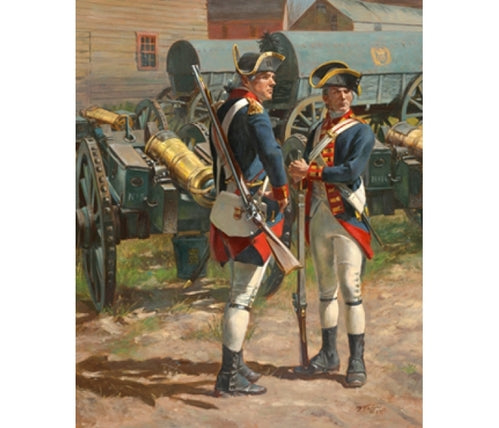W.Britains
The Royal Regiment of Artillery 1775
The Royal Regiment of Artillery 1775
Couldn't load pickup availability
This is Don Troiani print - The Royal Regiment of Artillery 1775.
Available Format of Print:
350 Signed/Numbered Print (available)
Overall: 15.375" x 19"
Image: 11.375" x 14.5"
$75.00
Artist Proof (available)
50 Signed/Numbered
Overall: 15.375" x 19"
Image: 11.375" x 14.5"
$100.00
Canvas Giclee (printed as ordered)
15 Signed/Numbered
Overall: 16" x 20"
$600.00
The 4th Battalion of Royal Artillery (RA) was formed on 1 January 1771, consisting of eight companies, each commanded by a captain, with 3 subaltern officers, 2 sergeants, 2 corporals, 4 bombardiers, 8 gunners, 52 matrosses (private artillery soldiers) and 2 drummers. In 1773, the entire battalion was ordered to America as a major reinforcement to the regular forces on that continent under the command of General Thomas Gage, whose headquarters was then in New York. The 4th, under the command of Colonel Samuel Cleaveland, arrived at that city on July 8th (less one company assigned to Newfoundland). By 1775, most of the British army in America was concentrated in Boston, including five companies of the 4thBattalion, the other two companies have been sent to Canada.
On April 19, 1775, two field pieces—six-pounder cannon--accompanied the relief column under Lord Percy sent out to Lexington and Concord from Boston. The RA crews manning these guns were instrumental in covering the retreat of the grenadier and light infantry, that is, until each gun expended all 24 rounds carried in their respective side boxes (Lord Percy having refused to allow an ammunition wagon carrying another 140 rounds to accompany the column, for fear that it might retard its march--a decision that had fatal consequences). This was the opening engagement of the American War for Independence, which grew into a global conflict in the course of eight years' duration and in which Royal Artillery detachments served with great distinction in nearly every land battle or siege and even some at sea (the mortars of Royal Navy bomb ketches being also manned by the RA).
A Royal Artillery sergeant converses with a matross before a "light six" of the type used on the Concord relief. These field pieces were mounted on field carriages originally designed in the late 1740s and still in use at the opening of the war, although they began to be replaced in 1776 by a new design that became known as the "Congreve carriage" after its "inventor", Captain William Congreve of the 4th Battalion (who returned to England in late 1775 to supervise the construction of lighter, more versatile field carriages based on his experiences with artillery on American service). In the background can be seen part of the "artillery park", including additional six pounders and canvas-topped ammunition wagons--all painted with "lead grey" and bearing RA markings. They wear the full-dress uniform of this elite corps, which consisted of royal blue coats with scarlet facings and linings, with white waistcoats and breeches, all trimmed with plain yellow metal buttons (gilt for officers and brass for other ranks). The sergeant's status as senior non-commissioned officers is denoted by gold-laced buttonholes on his coat and a pair of gold-laced epaulettes on his shoulders, while the matross wears a uniform trimmed with yellow worsted lace. Both wear cocked hats with gold lace binding, the sergeant's trimmed with the black feather plume that Colonel Cleaveland instituted as a distinction for non-coms. The whitened-buff flap of his "gunner's pouch & priming horn" can be seen at his right hip below the butt of the slung, artillery carbine, while a brass-mounted sword and bayonet are slung on a belt from the opposite shoulder; the matross is similarly accoutred and armed (but sans sword). Distinctive tools of their trade mounted to the fronts of their pouch belts (consisting of a brass-headed hammer, vent spike, and priming wire) are polished and burnished, while their hair is powdered and white stocks tightly fastened around their necks--all suggesting that a full dress parade or guard mount is in the offing for these elite specialists.
James L. Kochan
Share


Continue Shopping
See more of the Breagans' collection of manufacturers from all around the world
Subscribe to our emails
Subscribe to our mailing list for insider news, product launches, and more.

